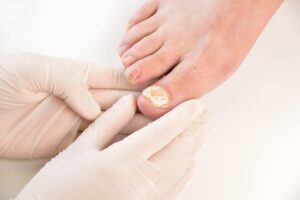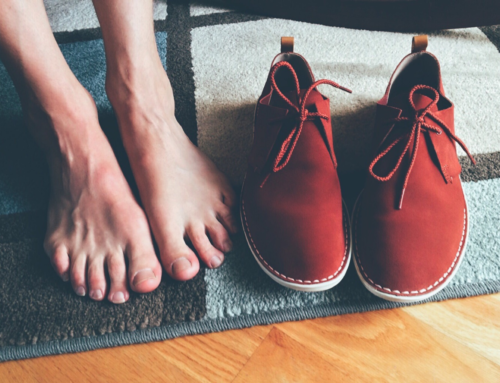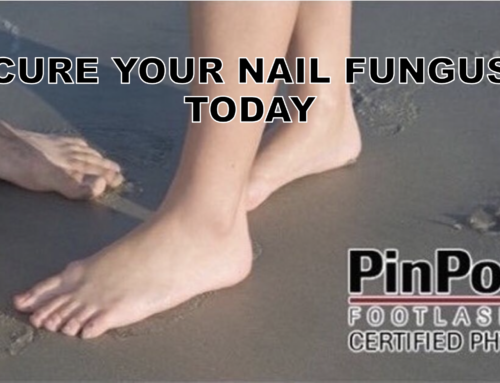Toenail fungus specialists in Philadelphia are nail doctors. It is important to go see a nail doctor. You need to have all the necessary information before deciding on the best treatment option. In our clinics, you can schedule a consultation to first speak with a nail specialist. After the doctor evaluates you, they will explain what treatment options would be best for you.
Common Symptoms
Here are some of the most common toenail fungus symptoms.
- Discoloration
- Yellowing is the most common one. Also, it does not necessarily have to be your entire nail discolored
- Other discolorations can include white streaks on your nail
- In severe cases, the nail can become brown or black in color
- Brittleness of toenails
- Your nails can become brittle
- They begin to crack or break
- The thickness of the toenails
- Many people develop a thickening of the nail
- As a result, makes it hard to trim and maintain your nails
- Nail Traumas
- If you injure your nail, it can lead to a toenail fungus

How Nail Fungus Works
A nail fungus infection starts with a negligible amount of fungus invading the nail bed. From that point, the fungus can start to grow and take up more and more space under the nail. Since fungal spores themselves are microscopic, they often can’t be seen with the naked eye until they have grown to a larger quantity. Only when the fungal spores have grown for a period of time will you be able to notice a visual change in your nail. This means that invisible nail fungus can be living under your nail without showing any signs of infection!
This is important for a couple of reasons. On one hand, this information should make you keener on keeping up with your shoe and foot hygiene at all times, even if you and those in close contact don’t have any visual signs of fungus. On the other hand, the potential presence of invisible nail fungus changes how the fungus must be treated. If you have a visible fungal infection on only one toe, some invisible nail fungus spores are likely on your other toes. Because of this, it is important to treat all of the nails on each affected foot to minimize the possibility of reinfection. This is what our doctors do when they use the PinPointe laser for fungus.
How to Avoid Toenail Fungus
There are a few ways you can avoid toenail fungus. Toenail fungus typically thrives in warm, moist environments, so it is important to be extra careful during hot summers. Here are some tips on avoiding a toenail fungus infection.
- Always wear shoes in public spaces
- This includes swimming pools, hot tubs, hot springs, gyms, locker rooms, saunas, and any indoor activity facility
- You can get infected by walking barefoot in an area where there are a lot of people
- Try not to wear closed-toe shoes for an extended period of time
- Wearing tight, closed-toe shoes can create the perfect environment for a toenail fungus to form, and it can spread to your toenails
- Avoid wearing closed-toe shoes for long periods of time, especially in the summertime when it is hot
- Avoid going to Nail Salons
- Many people get infected by going to nail salons
- Make sure that if you do go, it is clean and sanitized
- All tools should be freshly sanitized and unused
- Make sure everything is thoroughly cleaned between each client
- Do not share nail clippers
- Never share your nail clippers with someone else, as you can easily get infected with a toenail fungus
- As a result, if a person who has toenail fungus uses your nail clippers and doesn’t disinfect them, then you can get all your nails infected with toenail fungus
- Furthermore, make sure to always clean and disinfect your nail clippers and all other nail tools used to maintain your nails
By following these few tips, you can avoid getting a toenail fungus infection.
Treatment Options Available
- Topical treatments: Topical nail fungus treatments include over-the-counter creams such as tolnaftate and clotrimazole. These are very affordable and good at preventing fungal infections. Although they are not effective at treating an active infection, they are less than 10% effective.
- Oral pills: You might have heard of Lamisil (generic name terbinafine), amongst others, when it comes to nail fungus treatment. This is the most common option, even though it has extreme side effects, which include liver toxicity and even possibly liver damage, ultimately leading to death or the necessity of a liver transplant. It is so damaging. In fact, routine testing is required. It monitors the health of your liver for the entirety. While this may be the most common nail fungus treatment option, it is the one with the most drawbacks. And on top of this, the average cure rate for oral pills is only 60%!
- Laser: Laser is the most modern and technologically advanced nail fungus treatment option, with the greatest success rate. However, unfortunately, there are many different lasers on the market with various success rates, which may or may not be FDA-approved. To add on top of that, it only takes one treatment with no downtime afterward, while other lasers may require up to four sessions.
Laser Treatment for a Toenail Fungus in Philadelphia
Toenail fungus treatments in Philadelphia can vary. If you have caught nail fungus, it can be easily treated using the FDA-approved PinPointe laser, which typically only takes one treatment. Other treatments, like topical solutions and oral medication, are not as effective. Topical solutions have a very low cure rate. This is because the solution does not penetrate all the way through the nail bed. Oral medication has a higher cure rate than topicals, but our nail doctors do not recommend it. This is because it can lead to liver toxicity. You would need to have consistent blood tests throughout the course of taking the medication.
Our nail doctor in Philadelphia, PA, recommends this treatment for toenail fungus. The PinPointe Laser treatment has the highest cure rate in the market. It has no side effects and no recovery period. As a result, you can go about your daily activities right after the treatment. Also, there’s no pain.
If you have any signs of nail fungus, call us at 800-672-0625 at our Philadelphia, PA location, or visit our website for more information on our doctors at one of our over 150 locations.
Fun things to do in Philadelphia, PA
Philadelphia, Pennsylvania, is a city that perfectly blends rich American history with vibrant modern culture. Known for its iconic landmarks, world-class museums, and unbeatable food scene, Philadelphia offers something for every type of traveler. From the nation’s most historic sites like Independence Hall and the Liberty Bell to the lively neighborhoods filled with art, music, and cuisine, the city radiates energy and character.
A walk through history
Philadelphia, known as the “City of Brotherly Love,” is a place where history, culture, and modern attractions come together beautifully. Visitors can begin their journey in the heart of the city’s historic district, where Independence Hall stands as one of the most significant landmarks in American history. It was here that the Declaration of Independence and the U.S. Constitution were both debated and signed, marking the birth of the nation. Just steps away, the Liberty Bell Center houses one of the most iconic symbols of freedom — the cracked Liberty Bell. These sites are part of Independence National Historical Park, a must-visit destination that allows travelers to step back in time and appreciate the origins of the United States. To make the most of this area, early visits or pre-booked tours are recommended, as it’s one of the busiest attractions in Philadelphia.
Dive into the arts and culture
Beyond its historical sites, Philadelphia offers a thriving art and cultural scene. The Philadelphia Museum of Art is one of the largest art museums in the country, boasting an impressive collection that spans centuries and continents. Yet, it’s perhaps most famous for its “Rocky Steps,” made legendary by the famous movie scene where the fictional boxer triumphantly runs up the staircase. Visitors can reenact this iconic moment, snap a photo beside the Rocky statue, and enjoy a breathtaking view of the city skyline. Nearby, the Barnes Foundation showcases world-class works by Renoir, Cézanne, and Matisse, while the Franklin Institute inspires curiosity with its interactive science exhibits. For those seeking to explore African American culture and history, the African American Museum in Philadelphia offers thought-provoking exhibits and stories that highlight the city’s cultural richness.
Food lovers paradise
A trip to Philadelphia wouldn’t be complete without indulging in its diverse food scene and exploring its lively neighborhoods. The Reading Terminal Market is a perfect spot to taste local favorites and international cuisines, from authentic Pennsylvania Dutch treats to freshly baked goods and seafood. Food enthusiasts should also make time for South Philadelphia’s Italian Market, one of the oldest and largest open-air markets in the country. This area is not only great for dining but also for experiencing the city’s vibrant community atmosphere. Of course, no visit to Philadelphia is complete without trying the world-famous Philly cheesesteak from popular spots like Pat’s King of Steaks or Geno’s Steaks. Each neighborhood, from the trendy Fishtown area to the colorful mural-filled streets of South Philly, offers a distinct vibe that showcases the city’s creativity and charm.
A unique path
For travelers looking for something off the beaten path, Philadelphia also has its share of unique attractions. The Eastern State Penitentiary, once home to notorious criminals like Al Capone, offers an eerie yet fascinating look into the city’s past. Elfreth’s Alley, the oldest continuously inhabited residential street in America, gives visitors a glimpse into 18th-century life with its beautifully preserved row houses. Those who love the outdoors can unwind along the Schuylkill River Trail, which provides scenic walking and biking paths through the city. Whether you’re drawn to history, art, food, or adventure, Philadelphia captures the essence of American spirit and creativity, making it a city that truly has something for everyone.
Schedule a Consultation
If you have any signs of toenail fungus, don’t wait. Our Philadelphia, PA nail doctors offer the PinPointe laser treatment, the most effective and safe method for curing toenail fungus. Call us today at (800) 672-0625 or visit our website to schedule a free consultation at a location near you.




